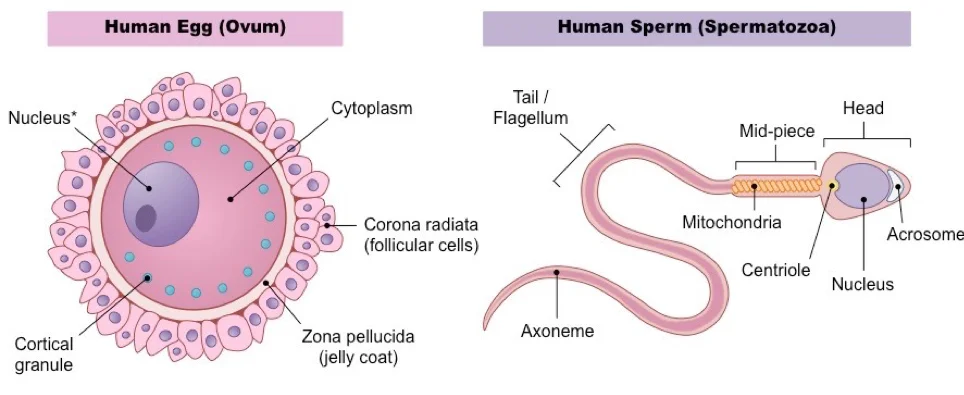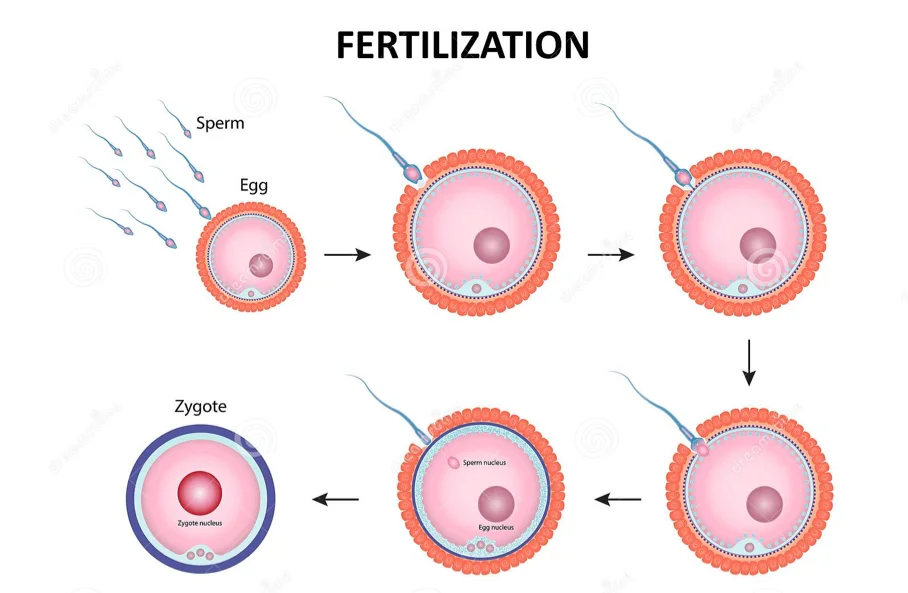A cell-cell recognition mechanism between two dissimilar cells : a small, asymmetric, motile sperm cell and a big, non-motile egg.
Eggs
- Eggs are symmetrical, nonmotile cells that are big (100 m).
- Human eggs are halted in the second meiotic division’s metaphase and only complete meiosis after fertilization.
- Microvilli cover the surface of their bodies.
- The zona pellucida, a glycoprotein coat made up of three glycoproteins, surrounds eggs.
- O- and N-linked oligosaccharides are found in all three glycoproteins.
- The zona pellucida is not an osmotic barrier, but it does act as a sperm barrier.
- The zona pellucida is a species-specific fertilization barrier.

Sperm
Sperm are three-component cells that are tiny, asymmetrical, and motile.
1. Tail: Also known as the main component. The flagellar apparatus, which is made up of “9 + 2” microtubules and accessory structures, are found in the tail.
2. Midpiece: located at the proximal end of the tail, the midpiece contains a sheath of mitochondria that provide the ATP required for a tail beating.
3. The spermatic haploid nucleus is found in the head.
- The acrosome, a membrane-bound vesicle, sits on top of the head and originates from the Golgi, a lysosomal-like compartment.
- It contains soluble hydrolases (serine protease acrosin) and has a low pH.
- During the acrosome reaction, the plasma membrane fuses with the outer acrosomal membrane, releasing the contents of the acrosome and exposing the inner acrosomal membrane as the sperm head’s functional outer boundary.
- The sperm plasma membrane is likewise highly specialized, with proteins localized in specific areas.
- PH-30, also known as fertilin, is a protein found in the equatorial region of sperm that aids in sperm-egg plasma membrane fusion.
- Sperm provides nucleus, centriole, mitochondria, and cytoplasm nevertheless, mitochondria and mitochondrial DNA are destroyed.
- Several sperm proteins and mRNAs for transcription and paracrine factors are delivered into the egg.
- The microRNAs imported: may down-regulate receptors implicated in early cell division.
Steps of Fertilization

1. Capacitation
- The sperm in the ejaculation are not ready to fertilize an egg.
- They go through a series of modifications in response to the dilution of semen, which are collectively known as capacitation and takes 5-7 hours.
- Only about 200 of the 300,000,000 human sperm ejaculated during coitus make it to the oviduct, where they are fertilized.
- The spermatozoa mature and become capable of fusing with the oocyte throughout their migration via the uterus and oviduct.
- The spermatozoa become hyperactivated after capacitation, allowing them to undergo an acrosome reaction and pass through the zona pellucida.
2. Penetration through follicle cells
- The follicle cells are embedded in a hyaluronic acid-based extracellular matrix.
- By dispersing the spermatozoa, they are able to penetrate the follicular cells.
- Hyaluronidase, which is found in the plasma membrane and acrosome of spermatozoa, disperses the follicular cells. The enzyme hyaluronidase breaks down hyaluronic acid.
3. Acrosome Reaction
- Through a particular ligand-receptor interaction, the sperm head connects to the zona pellucida.
- The acrosome vesiculates and releases enzymes on the zona pellucida as a result of the binding process. The acrosome’s outer plasma membrane merges with the plasma membrane at several points, releasing the acrosome’s contents. It’s called acrosome reaction.
- At the point of contact, acrosomal enzymes break down the zona pelludica.
- Acrosin, a serine protease, and N-acetylglucosaminidase are two key components. Acrosin creates a hole in the zona pellucida, allowing sperm to reach the egg.
- The O-linked oligosaccharides in zona pellucida glycoprotein III (ZPGP III) are hydrolyzed by N-acetylglucosaminidase, allowing the sperm to detach.
- A new surface on the sperm (the inner acrosomal membrane) is exposed as a result of membrane fusion, and this is expected to contain novel binding sites for ZPGP II.
- Spermatozoa that have not gone through the acrosome response are unable to penetrate the zona pellucida and fertilize.
4. Zona Penetration
- The zona pellucida is penetrated by acrosome reacted spermatozoa.
- Enzymatic digestion of the zona pellucida and pushing thrust generated by spermatozoa’s hyperactive motility may facilitate this process.
5. Sperm Oocyte Fusion
- The plasma membrane of the spermatozoon meets the plasma membrane of the oocyte after zona penetration.
- The two-membrane fuse is a type of fuse that has two membranes. The spermatozoon penetrates the cytoplasm of the oocyte.
- The cortical granules of the oocytes are released quickly after sperm-oocyte fusion, react with the zona pellucida, and render it impermeable to additional spermatozoa.
- The beating of the tail stops as soon as the sperm bonds with the egg.
- Instead, the sperm is attracted into the egg through the elongation and fusing of the egg’s microvilli, resulting in the sperm nucleus and other organelles being absorbed into the egg cytoplasm.
- To become a male pronucleus, the sperm nucleus goes through a series of modifications, including chromatin de-condensation and the development of a new nuclear envelope.
- Microtubules help the male pronucleus travel to the cell’s center, where it combines with the female pronucleus to form a diploid nucleus.
- Proteases, mucopolysaccharides, and peroxidases are present. As a result, multiple spermatozoa are frequently unable to penetrate the zona pellucida.
6. Pronuclear Development
- The oocyte is triggered after fusion and completes meiosis II division.
- The 2nd polar body is extruded, and a haploid female pronucleus is produced during anaphase II.
- Swollen male pronuclei are also formed by the sperm nucleus.
- The male and female pronuclei are found next to each other, however, they do not merge. The cell is called the zygote.